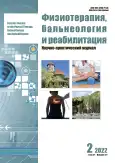EFFECTIVENESS OF LOW-INTENSITY RHYTHMIC TRANSCRANIAL MAGNETIC STIMULATION ON MOTOR AND NON-MOTOR MANIFESTATIONS OF PARKINSON'S DISEASE
- 作者: Borodulina I.V.1, Gerasimenko M.Y.2
-
隶属关系:
- Russian Medical Academy of Continuing Professional Education
- Russian Medical Academy of Continuous Professional Education
- 期: 卷 21, 编号 2 (2022)
- 页面: 115-121
- 栏目: Original studies
- URL: https://journals.rcsi.science/1681-3456/article/view/109139
- ID: 109139
如何引用文章
详细
Background. The use of repetitive transcranial magnetic stimulation (rTMS) as a method of non-drug therapy of Parkinson's disease (PD) has been actively studied over the past decades. The prevailing number of rTMS protocols in PD use a high intensity of stimulation (80-120% of the value of the threshold of the evoked motor threshold (MT) from the muscles of the hand), while the choice of the stimulation intensity parameter was carried out empirically.
Objective: to study the effectiveness of low-intensity unilateral rTMS on motor and non-motor symptoms of PD.
Methods. An open prospective non-randomized clinical trial included 37 patients with stage I-III PD according to Hoehn-Yahr, akinetic-rigid and mixed (akinetic-rigid-tremor) forms. All patients underwent rTMS according to the protocol: M1 stimulation zone, frequency 5 Hz, intensity 40% of the cortical motor threshold, on 6s, off 8s, total number of pulses per session 3000. The course of treatment is 10 procedures with 2 days (weekend) off.
Results. All patients completed the study in accordance with the protocol. When analyzing the results of the UPDRS scale, positive dynamics was noted in all parts of the questionnaire: part I from 2 (0;3) to 0 (0;1) points, p<0.05; part II from 9 (5.5;12.5) to 4 (2;6.5) points, p<0.05; part III with 11 (7;14.5) to 6 (2;7.5) points, p<0.05; part VI (Schwab and England scale) from 80% (70;95) to 90% (85;100), p<0.05. There was also a selective effect on non-motor symptoms.
Conclusion. Low-intensity exposure (40% of the MT) has a significant clinical effect on motor and non-motor symptoms of Parkinson's disease; stimulation of the primary motor cortex can have an antidepressant effect; rTMS has a selective effect on non-motor symptoms of Parkinson's disease: a predominant effect has been demonstrated with respect to olfactory, emotional, cognitive disorders, sleep disorders and hypersalivation; when assessing the dynamics of motor disorders, a more pronounced effect was noted with respect to rigidity, postural disorders, walking speed, and to a lesser extent, the effect on tremor was noted.
作者简介
Irina Borodulina
Russian Medical Academy of Continuing Professional Education
编辑信件的主要联系方式.
Email: irina.borodulina@gmail.com
ORCID iD: 0000-0001-7526-1553
SPIN 代码: 2152-5737
Cand. Sci. (Med.)
俄罗斯联邦, MoscowMarina Gerasimenko
Russian Medical Academy of Continuous Professional Education
Email: zaytn@mail.ru
ORCID iD: 0000-0002-1741-7246
SPIN 代码: 7625-6452
MD, Dr. Sci. (Med.), Professor
俄罗斯联邦, Moscow参考
补充文件






